The anti-tumor effect of A3 adenosine receptors is potentiated by pulsed electromagnetic fields in cultured neural cancer cells
- PMID: 22761760
- PMCID: PMC3382599
- DOI: 10.1371/journal.pone.0039317
The anti-tumor effect of A3 adenosine receptors is potentiated by pulsed electromagnetic fields in cultured neural cancer cells
Abstract
A(3) adenosine receptors (ARs) play a pivotal role in the development of cancer and their activation is involved in the inhibition of tumor growth. The effects of pulsed electromagnetic fields (PEMFs) on cancer have been controversially discussed and the detailed mechanisms are not yet fully understood. In the past we have demonstrated that PEMFs increased A(2A) and A(3)AR density and functionality in human neutrophils, human and bovine synoviocytes, and bovine chondrocytes. In the same cells, PEMF exposure increased the anti-inflammatory effect mediated by A(2A) and/or A(3)ARs. The primary aim of the present study was to evaluate if PEMF exposure potentiated the anti-tumor effect of A(3)ARs in PC12 rat adrenal pheochromocytoma and U87MG human glioblastoma cell lines in comparison with rat cortical neurons. Saturation binding assays and mRNA analysis revealed that PEMF exposure up-regulated A(2A) and A(3)ARs that are well coupled to adenylate cyclase activity and cAMP production. The activation of A(2A) and A(3)ARs resulted in the decrease of nuclear factor-kappa B (NF-kB) levels in tumor cells, whilst only A(3)ARs are involved in the increase of p53 expression. A(3)AR stimulation mediated an inhibition of tumor cell proliferation evaluated by thymidine incorporation. An increase of cytotoxicity by lactate dehydrogenase (LDH) release and apoptosis by caspase-3 activation in PC12 and U87MG cells, but not in cortical neurons, was observed following A(3)AR activation. The effect of the A(3)AR agonist in tumor cells was enhanced in the presence of PEMFs and blocked by using a well-known selective antagonist. Together these results demonstrated that PEMF exposure significantly increases the anti-tumor effect modulated by A(3)ARs.
Conflict of interest statement
Figures
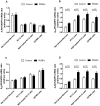
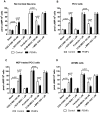
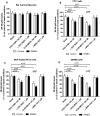
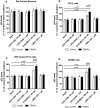
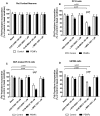
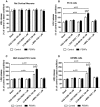
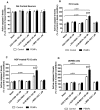
Similar articles
-
Pulsed electromagnetic fields increased the anti-inflammatory effect of A₂A and A₃ adenosine receptors in human T/C-28a2 chondrocytes and hFOB 1.19 osteoblasts.PLoS One. 2013 May 31;8(5):e65561. doi: 10.1371/journal.pone.0065561. Print 2013. PLoS One. 2013. PMID: 23741498 Free PMC article.
-
Characterization of adenosine receptors in bovine chondrocytes and fibroblast-like synoviocytes exposed to low frequency low energy pulsed electromagnetic fields.Osteoarthritis Cartilage. 2008 Mar;16(3):292-304. doi: 10.1016/j.joca.2007.07.004. Epub 2007 Aug 16. Osteoarthritis Cartilage. 2008. PMID: 17698373
-
Effect of pulsed electromagnetic field exposure on adenosine receptors in rat brain.Bioelectromagnetics. 2012 May;33(4):279-87. doi: 10.1002/bem.20704. Epub 2011 Oct 19. Bioelectromagnetics. 2012. PMID: 22012856
-
Pulsed Electromagnetic Fields: A Novel Attractive Therapeutic Opportunity for Neuroprotection After Acute Cerebral Ischemia.Neuromodulation. 2022 Dec;25(8):1240-1247. doi: 10.1111/ner.13489. Epub 2022 Feb 2. Neuromodulation. 2022. PMID: 34480781 Review.
-
Adenosine receptors and cancer.Handb Exp Pharmacol. 2009;(193):399-441. doi: 10.1007/978-3-540-89615-9_14. Handb Exp Pharmacol. 2009. PMID: 19639290 Free PMC article. Review.
Cited by
-
Purinergic signalling and cancer.Purinergic Signal. 2013 Dec;9(4):491-540. doi: 10.1007/s11302-013-9372-5. Purinergic Signal. 2013. PMID: 23797685 Free PMC article. Review.
-
Adenosine Receptors as a Biological Pathway for the Anti-Inflammatory and Beneficial Effects of Low Frequency Low Energy Pulsed Electromagnetic Fields.Mediators Inflamm. 2017;2017:2740963. doi: 10.1155/2017/2740963. Epub 2017 Feb 1. Mediators Inflamm. 2017. PMID: 28255202 Free PMC article. Review.
-
Patient Semi-specific Computational Modeling of Electromagnetic Stimulation Applied to Neuroprotective Treatments in Acute Ischemic Stroke.Sci Rep. 2020 Feb 19;10(1):2945. doi: 10.1038/s41598-020-59471-9. Sci Rep. 2020. PMID: 32075993 Free PMC article. Clinical Trial.
-
Pulsed-electromagnetic-field induced osteoblast differentiation requires activation of genes downstream of adenosine receptors A2A and A3.PLoS One. 2021 Feb 25;16(2):e0247659. doi: 10.1371/journal.pone.0247659. eCollection 2021. PLoS One. 2021. PMID: 33630907 Free PMC article.
-
A high throughput screening system of coils for ELF magnetic fields experiments: proof of concept on the proliferation of cancer cell lines.BMC Cancer. 2019 Feb 28;19(1):188. doi: 10.1186/s12885-019-5376-z. BMC Cancer. 2019. PMID: 30819144 Free PMC article.
References
-
- Borea PA, Gessi S, Bar-Yehuda S, Fishman P. A3 adenosine receptor: pharmacology and role in disease. Handb Exp Pharmacol. 2009;193:297–327. - PubMed
-
- Gessi S, Merighi S, Varani K, Borea PA. Adenosine receptors in health and disease. Adv Pharmacol. 2011;61:41–75. - PubMed
-
- Varani K, Padovan M, Govoni M, Vincenzi F, Trotta F, et al. The role of adenosine receptors in rheumatoid arthritis. Autoimmun Rev. 2010;10:61–64. - PubMed
-
- Gessi S, Merighi S, Sacchetto V, Simioni C, Borea PA. Adenosine receptors and cancer. Biochim Biophys Acta. 2011;1808:1400–1412. - PubMed
MeSH terms
Substances
LinkOut - more resources
Full Text Sources
Other Literature Sources
Medical
Research Materials
Miscellaneous

